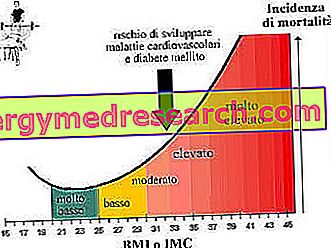The BMI is the index most used to obtain a general assessment of one's body weight The Body Mass Index (BMI) or Body Mass Index (BMI) is a parameter widely used to obtain a general assessment of one's body weight. It relates the height to the weight of the subject with a simple mathematical formula
Category anthropometry
Calf circumference and cardiovascular risk The circumference of the calf is an anthropometric measure used, similarly to the circumference of the arm, to evaluate the muscle mass of the subject. In some studies it has also been used to assess the health status of the subjects examined; for example, in Spain, a study conducted on 22, 000 people over the age of 65 found a significant correlation between reduced calf circumference and high risk of malnutrition; in France, a study conducted on 6, 265 people, always over the age of 65, found an inverse correlation between calf circumference and caro
See also: chest circumference and physical constitution The thoracic circumference can be measured under normal conditions, with maximum inspiration or maximum expiration. The first data is very useful for assessing the body growth of children and, in adulthood, to obtain an ideal weight estimate: Bernhardt's formula = (body height x chest circumference) / 240) The main limitation of Bernhardt's formula is the failure to take into account age, sex and degree of individual physical activity
The body circumferences express the transversal dimensions of the various segments of the human body. This is anthropometric data widely used in clinical practice, so that their value, correctly interpreted according to the reference standards, makes it possible to evaluate numerous factors in a practical, economic and with a reasonable reliability, among which we recall: the growth of an individual (head or arm circumference) the distribution of the subcutaneous adipose tissue (together with the folds) and the cardiovascular risk (abdominal circumference, waist / hip ratio or waist / thigh, ne
Body Constitution Being a region almost devoid of fat and muscle tissue, the circumference of the wrist provides useful information on the individual's body structure and morphology. Wrist circumference Morphological type man woman brevilinei > 20 cm > 18 cm normolinei 16 - 20 cm 14 - 18 cm long-limbed <16 cm <14 cm For a more precise evaluation, the following equation is used and compares the data obtained with the references listed in the table
The evaluation of body composition is used in various sectors such as medicine, anthropology, ergonomics, sport and auxology. Great interest is placed in the quantification of body fat in relation to the STATE OF HEALTH and SPORT PERFORMANCE Body composition evaluation is also used for: Identify the patient's health risk associated with excessively high or low levels of FM Identify the patient's health risk associated with excessive accumulation of intra-abdominal fat Monitor changes in body composition that are associated with certain diseases Changes in proportions during growth and a
In the last century coaches, athletic trainers, anthropologists and sports doctors have been interested in determining the "anthropometric" characteristics that allow maximum performance. Thus for years researchers have examined the physiological profile of high-level athletes, especially Olympians
See also: creatinine as an index of renal function Endogenous creatinine derives from its precursor, creatine, synthesized in the liver and kidney, and 98% localized in skeletal muscles in the form of creatine phosphate (CF or PC). Creatinine is formed by the non-enzymatic hydrolysis of free creatine during dephosphorylation of creatine phosphate
Today there are radiographic techniques such as DEXA, CT and MRI that allow to visualize and directly measure the variables of body composition (adipose tissue, bone tissue and muscle tissue). The main limitation of this equipment is that it is not very accessible and very expensive. DEXA: double energy x-ray absorptiometry It is based on the principle of differential attenuation of an X-ray beam, at two energy levels, when passing through tissues
What's this What is the impedance balance? The impedance scale is an electronic instrument designed for: Measure body weight - definable as the force exerted by the mass (quantity of matter) attracted towards the center of the planet thanks to the earth's gravity INDIRECTLY estimate, through the principle of impedance measurement - or impedance measurement - different parameters related to the composition of the same, for example the percentages of lean mass (FFM) and fat mass (FM), state of hydration, cell mass, etc
The Old BMI It is now known that the BMI represents a rapid but INDICATIVE indicator for assessing the body weight of a subject in relation to an ideal weight, called "ideal weight". Also known as the Quetelet index, from the name of the Belgian scientist Adolphe Quetelet who developed it as far back as 1830, the BMI stands for Body Mass Index, Italianized in "Body Mass Index" (IMC is synonymous with BMI) The BMI is obtained by dividing the weight (in kilograms) by the height (in meters) to the square of the subject in question





